Understanding How Google Search Positions Influence Click-Through Rates (CTR)
An in-depth exploration of how different ranking positions on Google’s search engine results page affect organic CTR.
Regardless of the type of business or medical practice you handle, leveraging Google’s search rankings typically involves several key factors. Your Click-Through Rate (CTR) is one of the primary metrics determining how well your page performs in search results.
Understanding CTRs is especially important for industries like healthcare, as the decision-making process is often more complex compared to other industries, such as auto and home goods, where purchases tend to be more straightforward.
This article explores the nuances of how different positions on Google’s SERPs impact CTRs, the impact of SERP features on CTR, and how factors like local packs, featured snippets, and rich results can either boost or divert clicks away from organic listings.
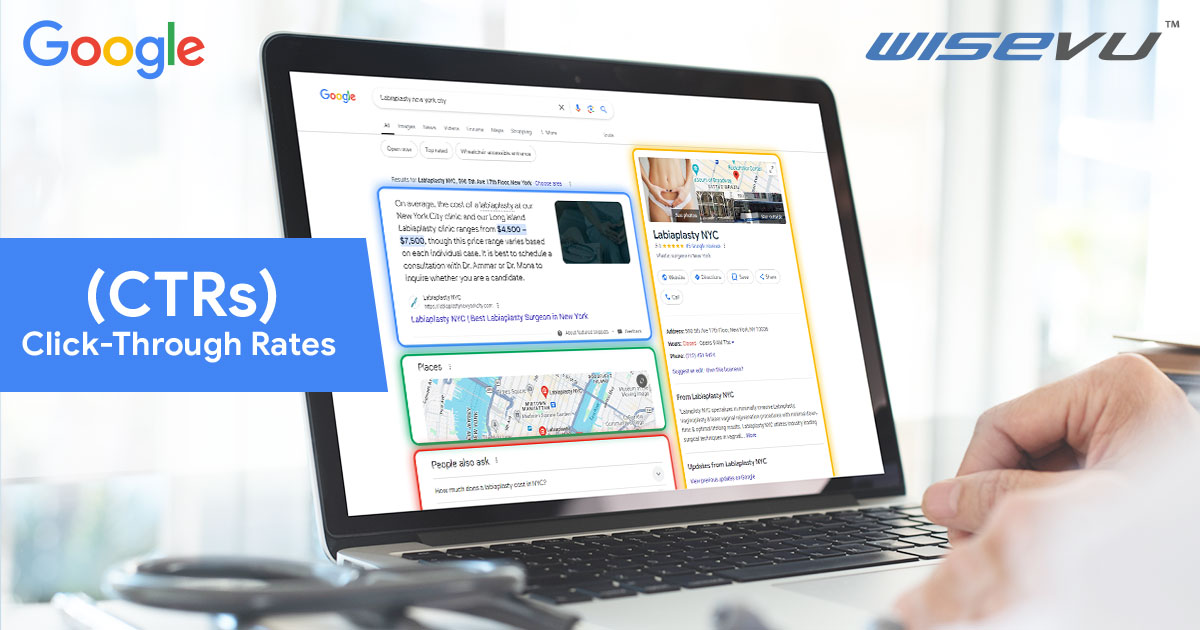
The Impact of Rankings on CTR: Why Being at the Top Matters
Websites that secure a position in the top three organic search results have significantly higher click-through rates. Based on data from Advanced Web Ranking1, the top-ranking website earns a staggering 45.44% of clicks, this means that nearly half of all users click on the top result.
In comparison, the second position sees a considerable drop to 17%, and the third receives 13.17%, while the other positions see only minor variations. From the fourth position down, the click-through rate steadily declines, with minimal differences between each rank.
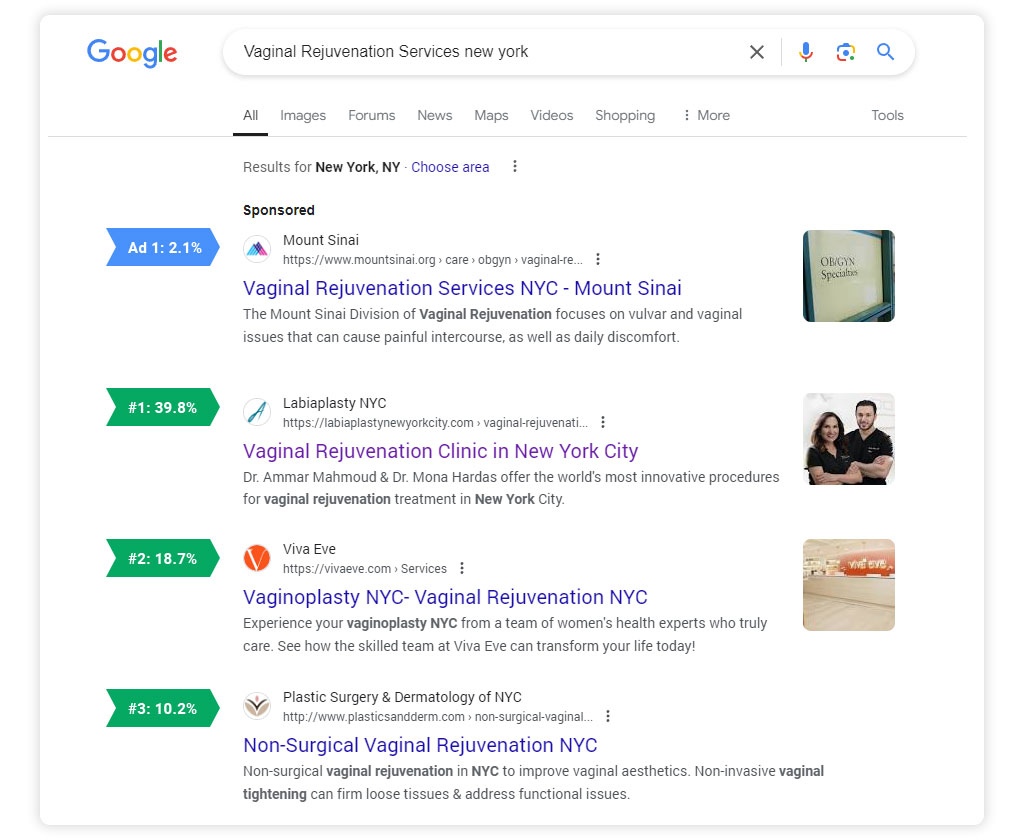
While most businesses attempt to secure the top-ranking position on search engine results organically, some also run paid search campaigns.
A Detailed Overview of Click-Through Rates by Industry
On average, Google Ads sees a click-through rate (CTR) of 3.17% for search campaigns and 0.46% for display campaigns across various industries. This data underscores the higher engagement potential of search-based advertising over display ads.2
Analyzing click-through rates (CTR) across various industries provides valuable insights into consumer engagement with search ads. The automotive industry, with an average CTR of 4.97%, demonstrates a high level of consumer interest, likely driven by the significant research that goes into vehicle purchasing decisions.
| Industry | Average CTR from Wordstream | Average Search Ads CTR from HubSpot | Average Search Ads CTR from Google & Microsoft Ads |
| Auto | 4.00% | 2.14% | 8.77% |
| Health & Medical | 3.27% | 1.79% | 6.44% |
| Real Estate | 3.71% | 2.03% | 9.09% |
| Home Goods | 2.44% | 1.80% | 4.80% |
| Industrial & Commercial | 2.61% | 1.40% | 5.57% |
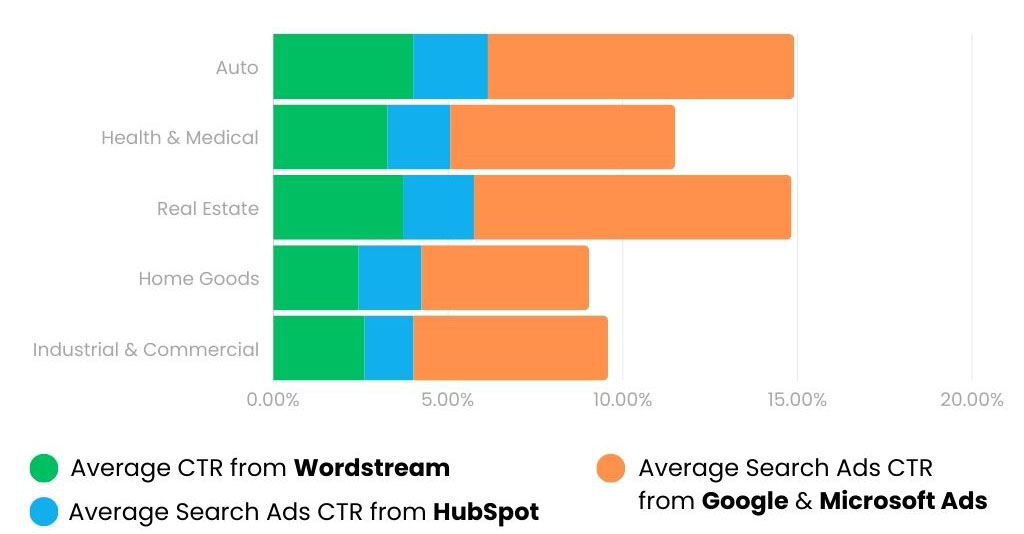
For the healthcare industry, it can be relatively more challenging to optimize CTR due to the complex nature of search intent and health-related online advertising. As a result, the average CTR for the medical industry tends to be lower than other sectors, hovering around 3.27% for medical practices.
This is because healthcare decisions typically involve significant deliberation. Patients tend to spend more time investigating symptoms, treatments, and potential providers, leading to a longer decision-making process and fewer immediate clicks.
These figures demonstrate how each industry needs tailored advertising strategies as they have varying consumer expectations and engagement patterns.
Organic CTR vs. Paid Search CTR
As Google’s SERP now includes both paid advertisements and organic listings, some businesses struggle to capture user attention as they feel that they have to compete with paid ads that appear above even the top organic results.
However, although paid ads may appear more prominent, they tend to have significantly lower CTRs than organic results. This is largely because users are more likely to click on organic results, which are viewed as more trustworthy and relevant.
In contrast to the 45.44% CTR for the top organic search result, the first position for paid ads sees a significantly lower CTR of just 2.1%.
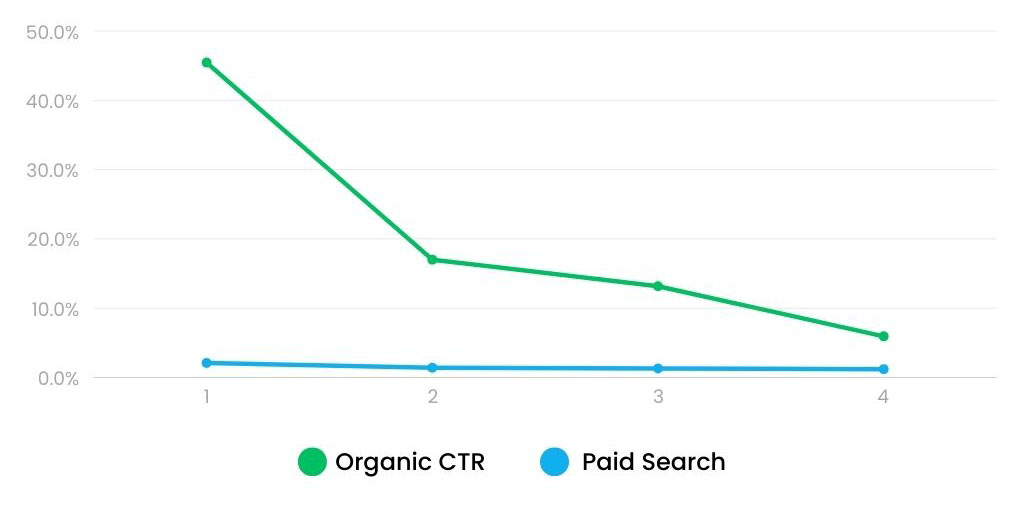
| Position | Organic Search CTR | Paid Search CTR |
| 1 | 45.44% | 2.1% |
| 2 | 17% | 1.4% |
| 3 | 13.17% | 1.3% |
| 4 | 5.93% | 1.2% |
Although paid search provides immediate results and highly targeted keyword campaigns, organic search not only has higher click-through rates but also delivers significantly lower cost per conversion than paid ads.
This is mainly due to the fact that more users trust organic results and perceive them as more authoritative, having been ranked by Google’s algorithms rather than paying for them.4
Maximizing the effectiveness of your site’s organic rankings and CTR goes beyond basic content optimization; it requires an understanding of user behaviour or search intent in relation to organic CTRs.
User Search Intent And How It Affects Clickthrough Rates (CTR)
Search intent is important for wise SEO. Creating content that matches your target audience’s queries and interests leads to more engagement.
There are four primary categories of user intent: informational, navigational, transactional, and commercial. Among the four primary categories of user intent, informational and commercial stand out as the most impactful on CTRs.
Commercial vs. Informational Searches
Searches with commercial intent often yield higher CTRs for the top organic positions, as these users are typically in the decision-making stage of a purchase.5 This is because users with a buying motive are more inclined to click on results that promise a quick and straightforward solution to their needs.
The disparity between commercial and informational search intent becomes increasingly apparent when examining click-through rates by position. For commercial searches, the first position in Google’s SERP commands a robust 24.05% CTR.
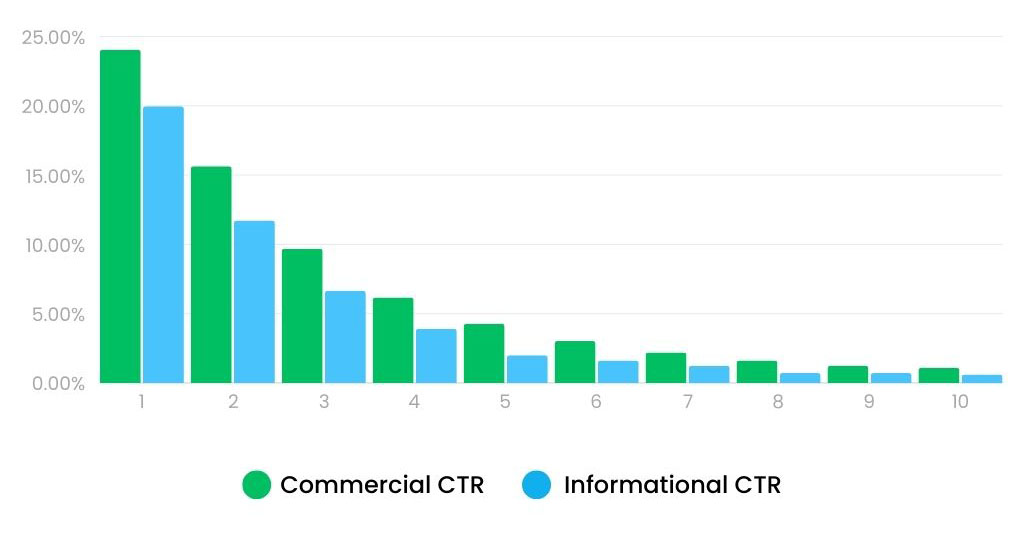
On the other hand, informational searches, while still substantial, see a lower CTR of 19.97% for the listing in the top position.
Commercial CTR vs. Informational CTR by Position
| Position | Commercial CTR | Informational CTR |
| 1 | 24.05% | 19.97% |
| 2 | 15.64% | 11.72% |
| 3 | 9.68% | 6.65% |
| 4 | 6.16% | 3.92% |
| 5 | 4.27% | 2..62% |
| 6 | 3.03% | 1.63% |
| 7 | 2.19% | 1.25% |
| 8 | 1.62% | 0.71% |
| 9 | 1.25% | 0.71% |
| 10 | 1.09% | 0.61% |
However, informational searches result in a more balanced distribution of CTRs across the board, as users generally seek diverse perspectives or multiple sources.6
In addition to understanding user behaviour and search intent, it’s also crucial to recognize how various SERP features, such as featured snippets, local packs, and more, influence CTR.
How SERP Features Influence Click-Through Rates
Apart from paid ads, SERP features like featured snippets, local packs, People Also Ask (PAA), and knowledge panels significantly affect users’ engagement with search results. These elements often appear at the top of search results, drawing attention away from organic listings and impacting overall click-through rates by providing quick answers or localized options.
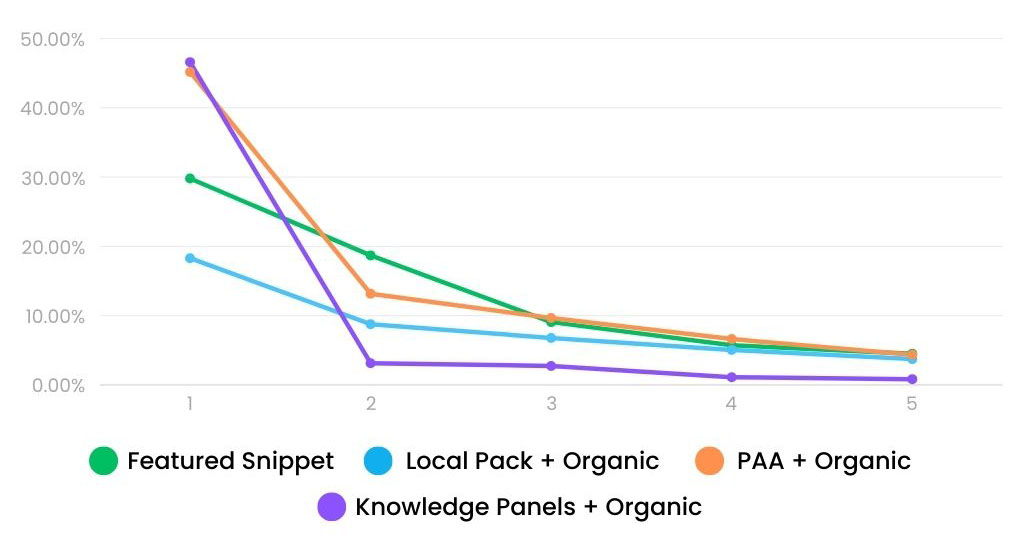
| Position | Featured Snippet | Local Pack + Organic | PAA + Organic | Knowledge Panels + Organic |
| 1 | 29.8% | 18.3% | 45.18% | 46.59% |
| 2 | 18.7% | 8.77% | 13.17% | 3.14% |
| 3 | 9.07% | 6.78% | 9.67% | 2.74% |
| 4 | 5.72% | 5.06% | 6.62% | 1.12% |
| 5 | 4.49% | 3.73% | 4.36% | 0.84% |
1. Featured Snippets
A featured snippet is a special block at the top of Google’s search results, designed to answer a user’s query immediately. It often includes a summary of the answer extracted from a webpage, along with the page’s title and URL.
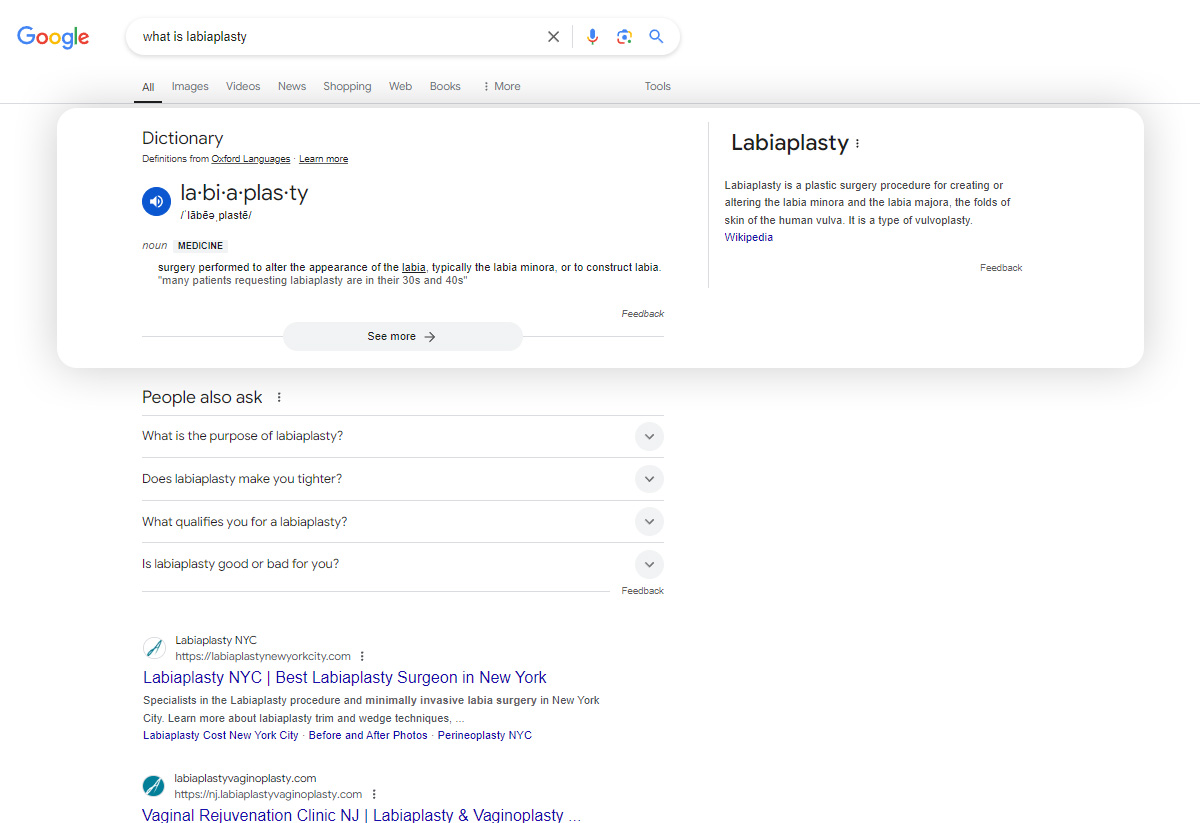
Featured snippets drive CTR by holding the top position on Google’s search page, attracting almost 30% of clicks. This is particularly beneficial for medical practices, where patients are drawn to the most visible and reliable source of health information.
2. Local Packs
Local packs, also known as the Local 3 Pack, the Google 3 Pack, or the Google Map Pack, is a search feature that displays the top three local businesses relevant to a user’s query. It shows up prominently on Google’s search results page, featuring key details like business names, reviews, and proximity.
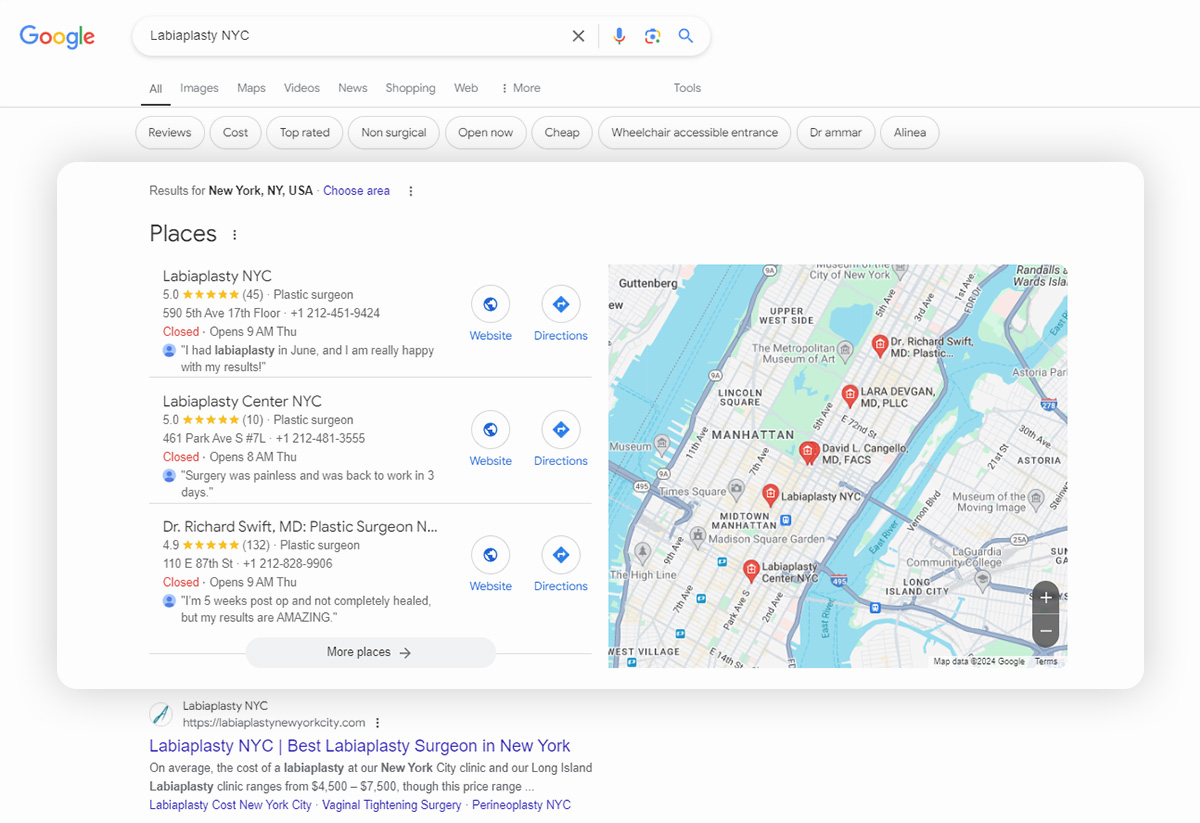
Since most medical searches have local intent, appearing in the local pack ensures that a medical practice is easily discoverable when patients search for services like “pediatrician near me” or “urgent care clinic.”
3. People Also Ask (PAA)
People Also Ask (PAA) is a Google feature that lists related questions often searched by users, offering quick answers without needing to visit multiple websites.
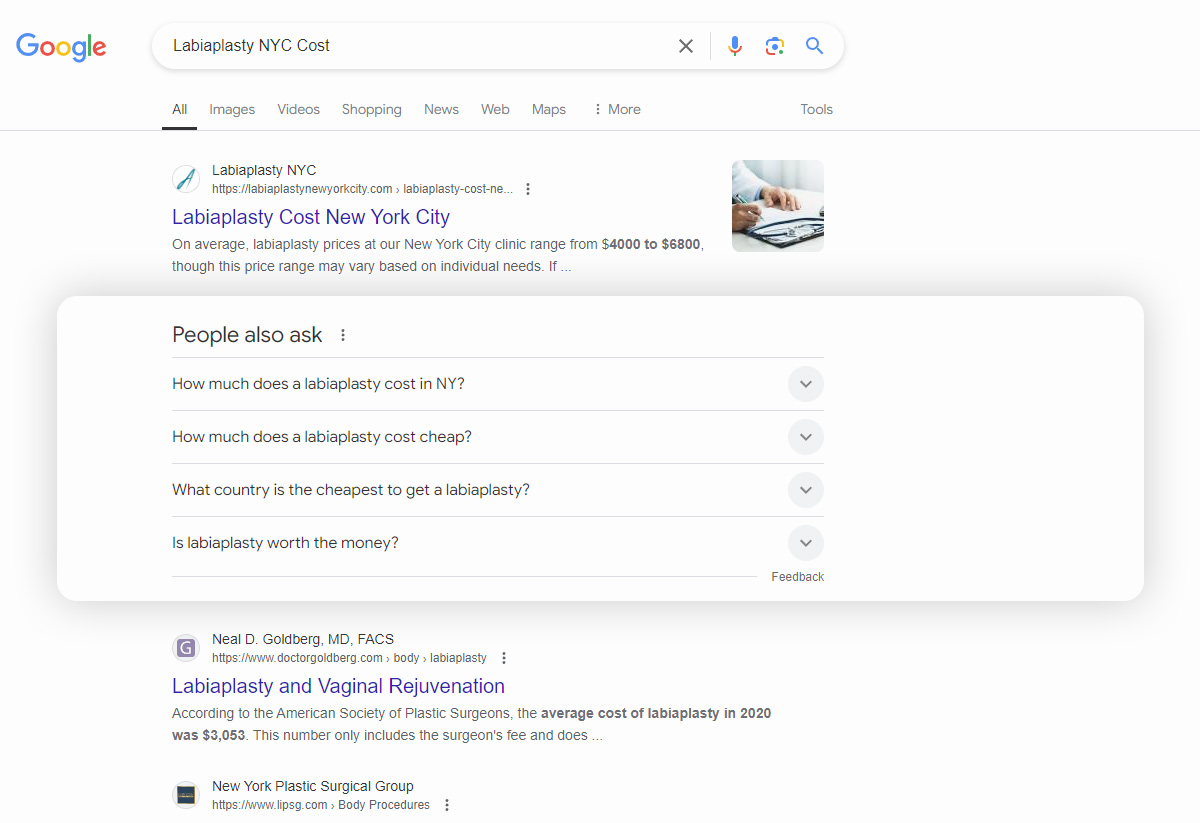
Appearing in the PAA box increases visibility, especially when users search for healthcare queries like “What are the symptoms of diabetes?” This boosts CTR by presenting your content as a trusted source for common medical questions. Having both a PAA feature and a top organic result allows you to capture up to 45.18% of clicks, giving your content a significant advantage.
4. Knowledge Panels
Knowledge panels are Google’s way of providing instant summaries of people, places, or things. These panels are auto-generated and draw from multiple sources, offering a quick snapshot of information based on Google’s data.8
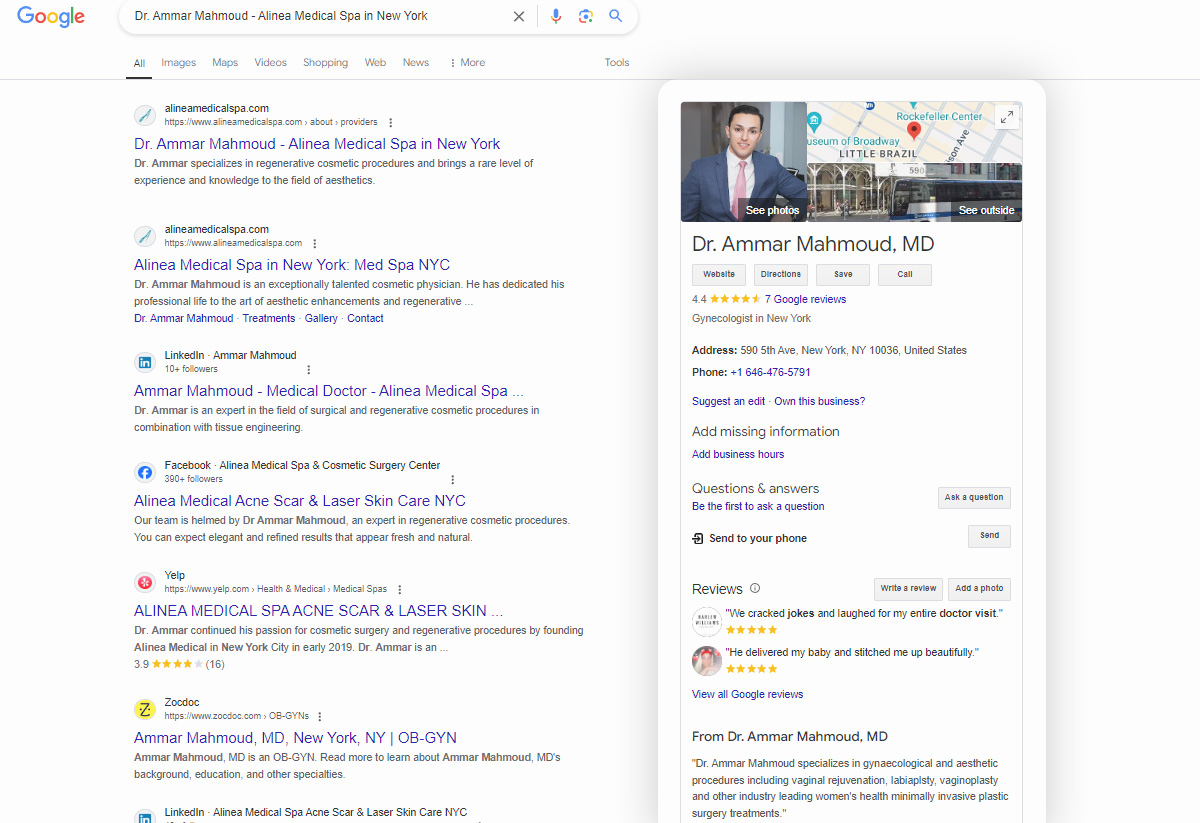
For medical practices, knowledge panels improve local SEO by displaying essential details, helping patients nearby find the practice quickly. This makes it easier for local patients to find them, increasing CTR as users tend to click on highly visible results.
In addition to these categories, recognizing the variance in click-through rates (CTRs) depending on whether the keywords are branded, non-branded, or fall within the spectrum of generic to long-tail keywords is also vital in building on our understanding of how CTRs work.
How Different Types of Keywords Affect Your CTR
Optimizing your keywords can also significantly affect your CTR, particularly when you consider how branded, unbranded, long-tail, and generic keywords work. Each of these types plays a different role in how users engage with search results, and understanding their impact is key to driving traffic.
Branded vs. Unbranded Keywords
Branded keywords, which include specific brand names, typically see higher CTRs due to users’ brand recognition and loyalty. Conversely, non-branded keywords, which are more generic, tend to have lower CTRs but can capture a broader audience.
| Position | Branded Keywords | Unbranded Keywords |
| 1 | 32.63% | 25.48% |
| 2 | 13.31% | 11.44% |
| 3 | 7.74% | 6.95% |
| 4 | 4.84% | 4.59% |
| 5 | 3.27% | 3.18% |
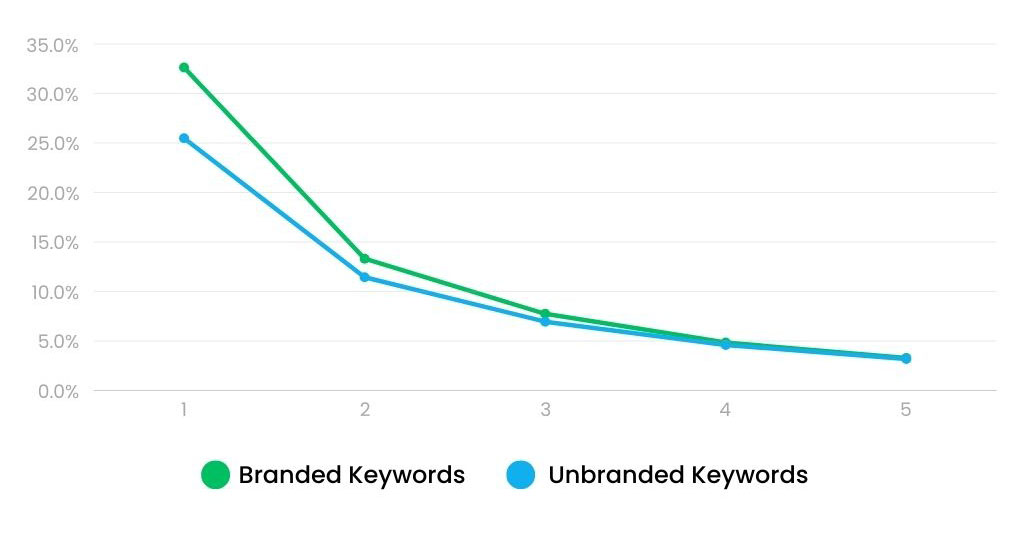
Branded keywords, which typically face less competition from paid advertisements, tend to have higher click-through rates, with the top position reaching up to a 32% CTR.
Another factor that can impact your site’s CTR is the type of keywords you choose—long-tail vs. generic.
Long-tail vs. Generic Keywords
Long-tail keywords are detailed, niche phrases with less competition. They work well for reaching specific audiences. Since these keywords are closely related to what users are searching for, they often result in more clicks. This is because they are highly relevant to the user’s exact search intent.
| Position | Longtail Keywords | Generic Keywords |
| 1 | 29.04% | 27.9% |
| 2 | 10.92% | 9.42% |
| 3 | 6.17% | 4.73% |
| 4 | 4.04% | 3.12% |
| 5 | 2.76% | 2.15% |
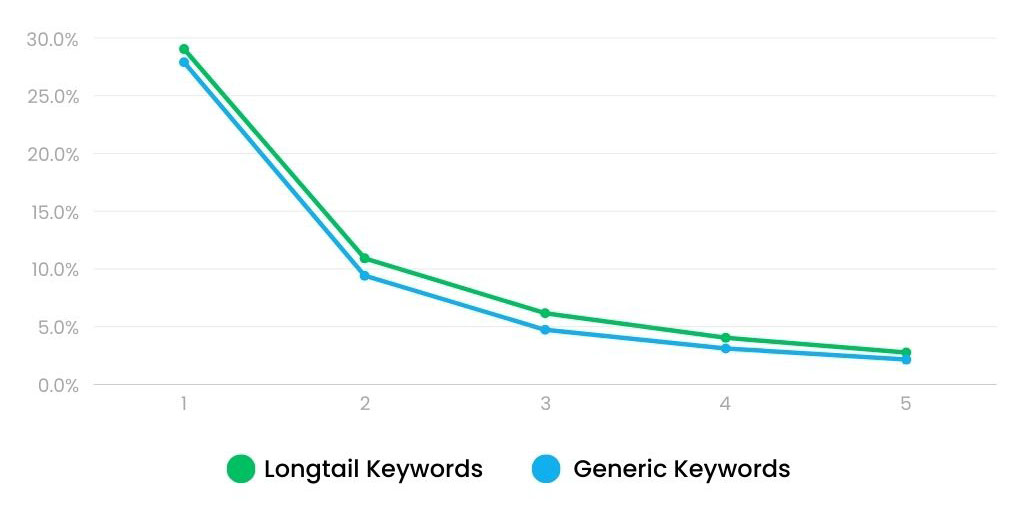
Meanwhile, generic searches that consist of just one or two words tend to have a steep decline in click-through rates after the top spot. In contrast, long-tail keywords, typically comprising four or more words, demonstrate a more stable click-through rate across various search result positions. This consistency sets them apart from shorter, more generic search terms.
Specific, detailed keywords, known as long-tail keywords, usually perform better in search results. They work well because they precisely match what people are looking for when purchasing something. Also, since there’s less competition for these phrases, they are really important for successful SEO.
As we’ve explored the influence of specific keywords and their impact on search rankings, it’s imperative to recognize that these effects vary across industries. Every industry has its unique traits, audience behaviour, and competitive dynamics. Analyzing CTR within specific sectors offers key insights into consumer preferences.
Conclusion
Understanding the intricacies of CTR in today’s digital landscape is crucial, and at Wisevu, this understanding is what allows us to develop tactical plans for our clients based on their individual search engine optimization budgets. We delve into the fine details of your industry’s CTR benchmarks, applying our insights to enhance your website’s visibility and click-through rates.
At Wisevu, our focus is on the top 3 positions, not just on the first page that most competing agencies focus on – which usually means the bottom or the middle of the first page.
With a strategic focus on organic search results, we aim to optimize your web pages for the highest possible search ranking, ensuring that your business not only achieves but maintains a commanding online presence that translates into tangible growth in customer engagement and conversions. Book a free consultation and SEO Strategy Plan today.
References:
- Advanced Web Ranking. “Google Organic CTR History.” Advanced Web Ranking, www.advancedwebranking.com/free-seo-tools/google-organic-ctr.
- Chappell, Mark. “Google AdWords Industry Benchmarks.” WordStream, 29 Feb. 2016, www.wordstream.com/blog/ws/2016/02/29/google-adwords-industry-benchmarks. Accessed 8 Nov. 2023.
- Dean, Brian. “Google CTR Stats to Inform Your SEO Strategy in 2023.” Backlinko, https://backlinko.com/google-ctr-stats.
- Chaffey, Dave. “Comparison of Google Clickthrough Rates by Position.” Smart Insights, 20 Sept. 2023, www.smartinsights.com/search-engine-optimisation-seo/seo-analytics/comparison-of-google-clickthrough-rates-by-position/.
- “Mission ImposSERPble 2: User Intent and Click Through Rates,” Moz. https://moz.com/blog/mission-imposserpble-2-user-intent-click-through-rates
- “What Is User Intent? Why Is It Important for SEO and CRO?” Noupe, https://www.noupe.com/business-online/what-is-user-intent.html.
- Chappell, Mark. “Google AdWords Industry Benchmarks.” WordStream, 29 Feb. 2016, www.wordstream.com/blog/ws/2016/02/29/google-adwords-industry-benchmarks. Accessed 8 Nov. 2023.
- Google. “Knowledge Panels.” Google Search Central Help, https://support.google.com/knowledgepanel/answer/9163198?hl=en.
